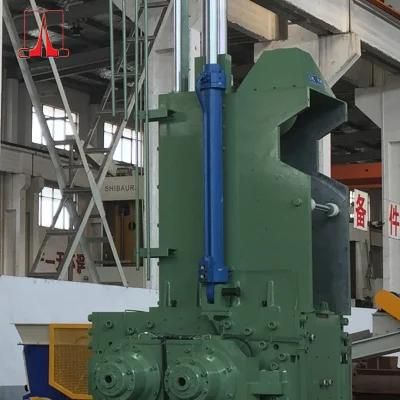
Plastic 200L Banbury Mill
Zhangjiagang Lanhang Machinery Co., Ltd.- Voltage:380V
- Power(W):1100000
- Dimension(L*W*H):8.1X3.5X5.4m
- Weight:48 T
- Motor for The Internal Mixer:Frequency Control or Not
- Motor for The Banbury Mixer:Inverter Rotor or Variable Speed Rotor
Base Info
- Model NO.:LH-200Y
- Rubber Banbury Mixer Rotor:Intermeshing Rotor
- Drive of Top Mounted Hammer:Pneumatic or Hydrauma
- Thickness of Wear-Resistant Alloy:5 mm
- Hardness of Banbury Mixer Rotor:50 HRC
- Transport Package:Wood Pallet & Film Wrap
- Specification:400L
- Trademark:LANHANG
- Origin:Jiangsu, China
- HS Code:84778000
- Production Capacity:200 Set,Sets Per Year
Description
Application of Our Plastic & Rubber Banbury Mixer
This intensive mixer has a wide range of applications, including in mixing and refining Raw materials, such as raw rubber, synthetic rubber, resin, asphalt, cellulose, PVC or EVA into even mixed stock. The body and structure of this machine are strong and durable, making it suitable for heavy-duty Rubber & Plastic mixing and refining operations.
Features of Plastic Banbury Mixer
1. Intermeshing or tangential rotor
2. Rotors, mixing chamber, harmmer and parts which contacts with the material are overlayed with 5mm wear-resistant alloy (up to 50HRC)
3. Pneumatic or hydraulic type top mounted ram is optional
4. Falling type floating weight which is driven by gear and hydraulic oil tank with good sealing performance.
5. Inverted AC motor or variable speed DC motor is optional
6. Drop / side door discharging
7. Copper-ring and hydraulic sealing
8. 2-wing, 4-wing, 6-wing are available
9. Excellent dispersing effect
10. Best mixing rotor and chamber to guarantee 100% mixing effect
11. LG brand electrical parts, Mitsubishi brand PLC, ABB motor
12. Low noise, safe mixing
13. Maintenance friendly and long-life service
Description of Plastic Banbury Mixer
The Banbury Mixer, which is invented by Fernley H. Banbury, was introduced to the rubber manufacturing industry in 1917. The machine is called a compounder, mixer, or blender. It mixes components together that do not readily blend but require a lot of energy to become homogeneous. The mixer is a batch operation and is used to blend rubber and plastics or many different materials with additives.
Working Principle of Rubber Banbury Mixer
The materials to be blended are introduced through a hopper. A ram pushes the materials into the mixing chamber. Two counter-rotating rotors provide the mixing action, much like double dough hooks. The blended batch is discharged through an opening in the bottom of the mixing chamber to the next processing step. Improvements made over the years include many design changes to enable easier operation and maintenance.
Heat transfer is closely controlled in the modern Banbury Mixer. The rotors generate a lot of friction with the material, so mixing is generally an exothermic process, giving off heat to the environment. Some mixes absorb heat and become cooler, however. In many processing operations, heat may be added to the system.
Internal pressure is also controllable, and many mixing operations occur under increased pressures and temperatures. This capability is necessary for the mixer to act as a reactor chamber in the manufacture of many polymers. Compounding of rubbers or rubber recycling is often spoken of as mastication and softening. While those terms imply the first steps of human digestion, the rubber is usually not chemically changed.
